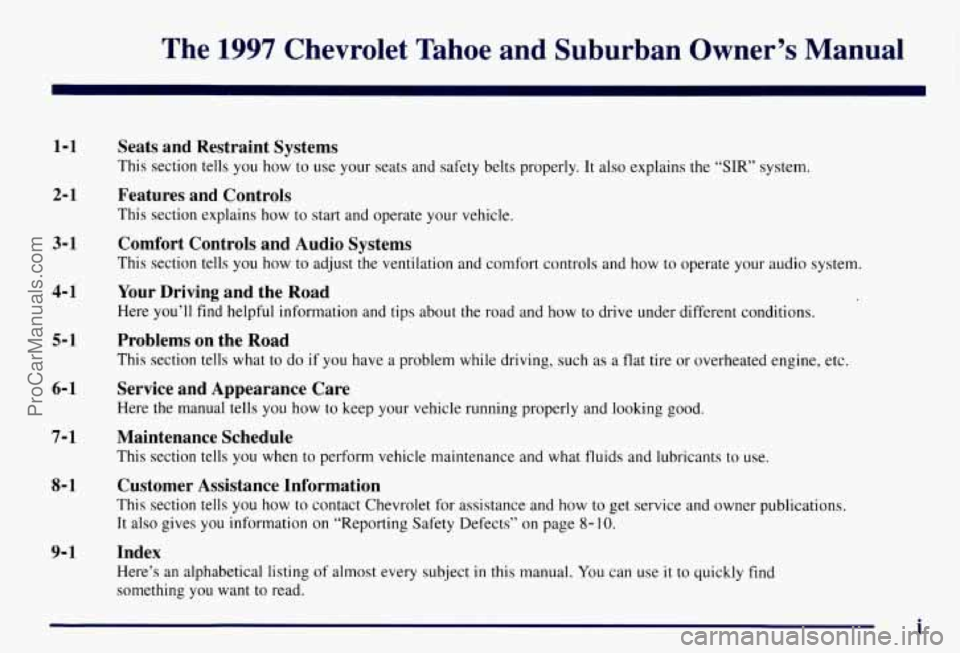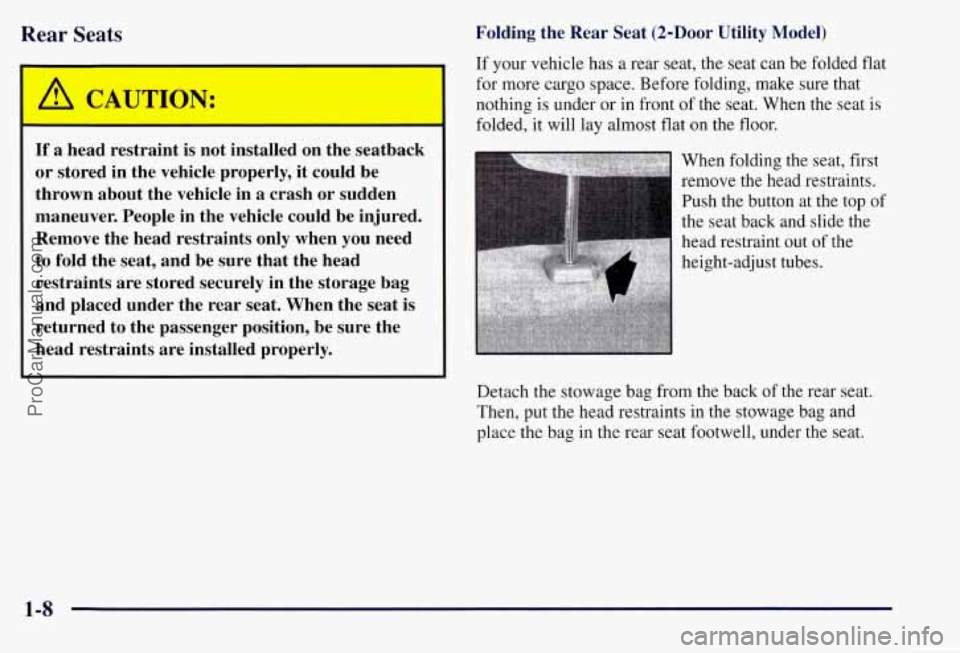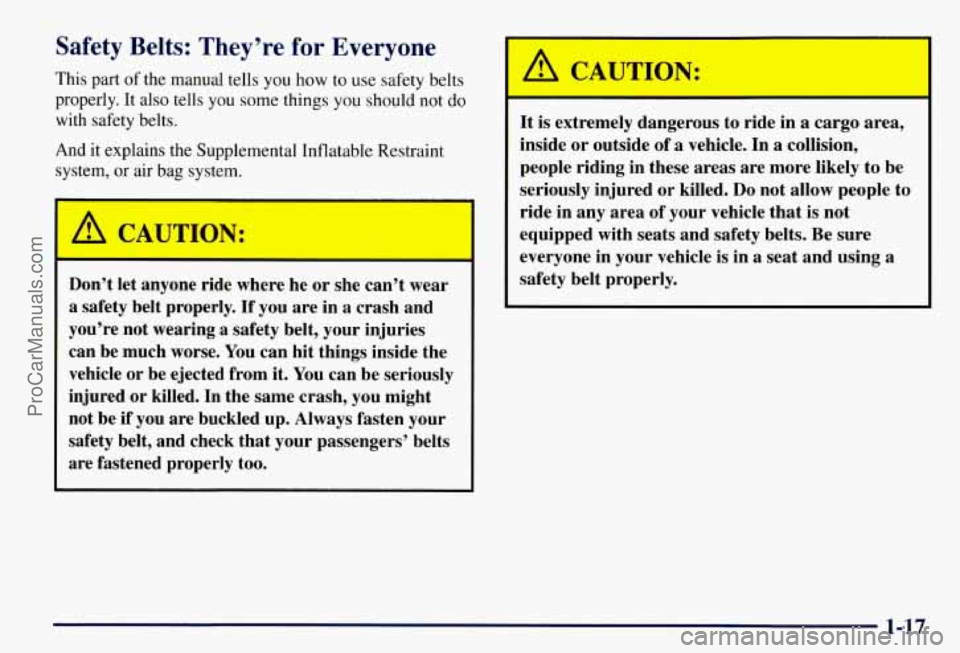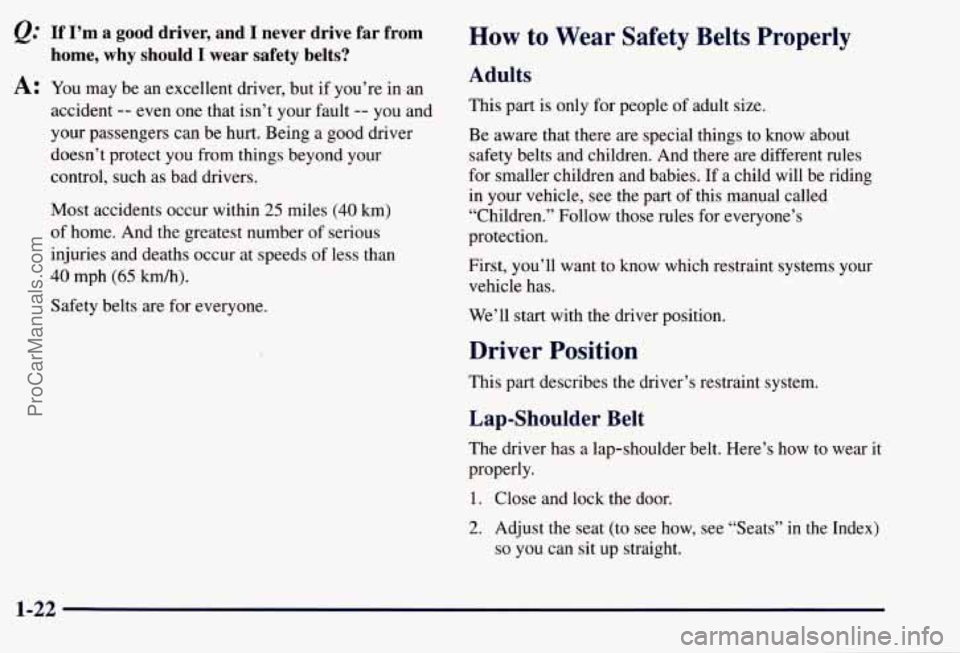Page 2 of 433

The 1997 Chevrolet Tahoe and Suburban Owner’s Manual
1-1
2-1
3-1
4-1
5- 1
6-1
7-1
8- 1
9- 1
Seats and Restraint Systems
This section tells you how to use your seats and safety belts properly. It also explains the “SIR’ system.
Features and Controls
This section explains how to start and operate your vehicle.
Comfort Controls and Audio Systems
This section tells you how to adjust the ventilation and comfort controls and how to operate your audio system.
Your Driving and the Road
Here you’ll find helpful information and tips about the road and how to drive under different conditions.
Problems on the Road
This section tells what to do if you have a problem while driving, such as a flat tire or overheated engine, etc.
Service and Appearance Care
Here the manual tells you how to keep your vehicle running properly and looking good.
Maintenance Schedule
This section tells you when to perform vehicle maintenance and what fluids and lubricants to use.
Customer Assistance Information
This section tells you how to contact Chevrolet for assistance and how to get service and owner publications.
It also gives you information on “Reporting Safety Defects” on page
8- 10.
Index
Here’s an alphabetical listing of almost every subject in this manual. You can use it to quickly find
something you want to read.
i
ProCarManuals.com
Page 8 of 433
Section 1 Seats and Restraint Systems
Here you’ll find information about the seats in your vehicle and how to use your safety belts properly. You can also
learn about some things you should
nut do with air bags and safety belts.
1-2
1-17 1-21
1-22
1-22
1-30
1-3 1
1-3 1
1-38 Seats and Seat Controls
Safety Belts:
They’re for Everyone
Here Are Questions Many People
Ask About
Safety Belts
-- and the Answers
How to Wear Safety Belts Properly
Driver Position
Safety Belt Use During Pregnancy
Right Front Passenger Position
Supplemental Inflatable Restraint System
Center Passenger Position 1-39
1-45
1-48
1-50
1-58
1-61
1-62
1-62 Rear Seat Passengers
Rear Safety Belt Comfort
Guides for Children
and Small Adults
Children
Child Restraints
Larger Children Safety Belt Extender
Checking Your Restraint Systems
Replacing Restraint System Parts
After a Crash
1-1
ProCarManuals.com
Page 9 of 433
Seats and Seat Controls
This section tells you about the seats -- how to adjust
them and fold them up and down. It also tells you about
reclining front seatbacks and head restraints.
Manual Front Seat
You can lose control of the vehicle if you try to
adjust a manual driver’s seat while the vehicle is
moving. The sudden movement could startle and
confuse you, or make you push a pedal when you
don’t want to. Adjust the driver’s seat only when
the vehicle is not moving.
If your vehicle has a manual
bucket, split bench or full
bench seat,
you can adjust it
with this lever at the front
of the seat.
1
Slide the lever at the front of the seat toward the
passenger’s side to unlock it. Using your body, slide the
seat to where you want it. Then, release the lever and try
to move the seat with your body to make sure the seat is
locked into place.
1-2
ProCarManuals.com
Page 15 of 433

Rear Seats
I
~ If a head restraint is not installed on the seatback
~ or stored in the vehicle properly, it could be
1 thrown about the vehicle in a crash or sudden
maneuver. People in the vehicle could be injured.
Remove the head restraints only-when you need
to fold the seat, and be sure that the head
restraints are stored securely in the storage bag
and placed under the rear seat. When the seat is
returned to the passenger position, be sure the
head restraints are installed properly. Folding
the Rear Seat (2-Door Utility Model)
If your vehicle has a rear seat, the seat can be folded flat
for more cargo space. Before folding, make sure that
nothing is under or in front of the seat. When the seat is
folded, it will lay almost flat on the floor.
When folding the seat, first
remove the head restraints.
Push the button at the top of
the seat back and slide the
head restraint out of the
height-adjust tubes.
Detach the stowage bag from the back of the rear seat.
Then, put the head restraints in the stowage bag and
place the bag in the rear seat footwell, under the seat.
1-8
ProCarManuals.com
Page 24 of 433

Safety Belts: They’re for Everyone
This part of the manual tells you how to use safety belts
properly. It also tells you some things you should not
do
with safety belts.
And it explains
the Supplemental Inflatable Restraint
system, or air bag system.
Don’t let anyone ride where he or she can’t wear
a safety belt properly.
If you are in a crash and
you’re not wearing a safety belt, your injuries
can be much worse. You can hit things inside the
vehicle or be ejected from it. You can be seriously
injured or killed.
In the same crash, you might
not be if you are buckled up. Always fasten your
safety belt, and check that your passengers’ belts
are fastened properly too. It
is extremely dangerous to ride in
a cargo area,
inside or outside of a vehicle. In a collision,
people riding in these areas are more likely to be
seriously injured or killed.
Do not allow people to
ride in any area of your vehicle that is not
equipped with seats and safety belts. Be sure
everyone in your vehicle is in a seat and using a
safety belt properly.
1-17
ProCarManuals.com
Page 29 of 433

If I’m a good driver, and I never drive far from
home, why should
I wear safety belts?
A: You may be an excellent driver, but if you’re in an
accident
-- even one that isn’t your fault -- you and
your passengers can be hurt. Being a good driver
doesn’t protect you from things beyond your
control, such as bad drivers.
Most accidents occur within
25 miles (40 km)
of home. And the greatest number of serious
injuries and deaths occur at speeds of less than
40 mph (65 kmh).
Safety belts are for everyone.
How to Wear Safety Belts Properly
Adults
This part is only for people of adult size.
Be aware that there
are special things to know about
safety belts and children. And there are different rules
for smaller children and babies. If a child will be riding
in your vehicle, see the part of this manual called
“Children.” Follow those rules for everyone’s
protection.
First, you’ll want to know which restraint systems your
vehicle has.
We’ll start with
the driver position.
Driver Position
This part describes the driver’s restraint system.
Lap-Shoulder Belt
The driver has a lap-shoulder belt. Here’s how to wear it
properly.
1. Close and lock the door.
2. Adjust the seat (to see how, see “Seats” in the Index)
so you can sit up straight.
1-22
ProCarManuals.com
Page 45 of 433
Center Passenger Position Lap Belt
If your vehicle has front and rear bench seats, someone
can sit in the center positions.
When you sit in a center seating position, you have a lap
safety belt, which has no retractor.
To make the belt
longer, tilt the latch plate and pull it along the belt.
1-38
ProCarManuals.com
Page 63 of 433
Securing a Child Restraint in the Right
Front Seat Position
Your vehicle has a right front passenger air bag. Never
put a rear-facing child restraint in this seat. Here’s why:
A child in a rearfacing child restraint can be
seriously injured if the right front passenger’s air
bag inflates. This is because the back of a
rearfacing child restraint would be very close to
the inflating air bag. Always secure a rear-facing child restraint in the rear seat.
I I
You’ll be using the lap-shoulder belt. See the earlier part
about the top strap if the child restraint has one.
1. Because your vehicle has a right front passenger air
bag, always move the seat as far back as it will go
before securing
a forward-facing child restraint. (See
“Seats’’ in the Index.)
2. Put the restraint on the seat. Follow the instructions
for the child restraint.
3. Secure the child in the child restraint as the
instructions say.
ProCarManuals.com